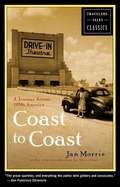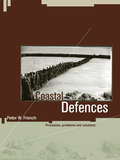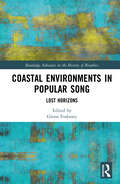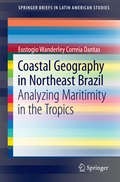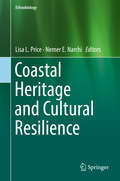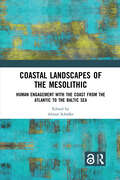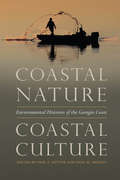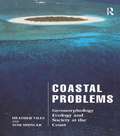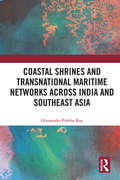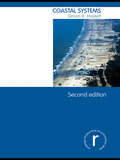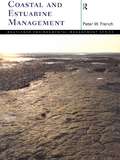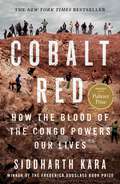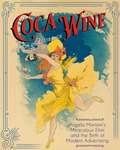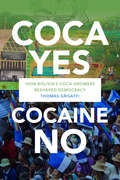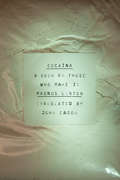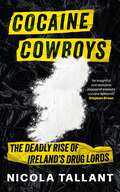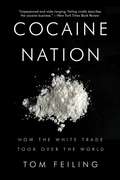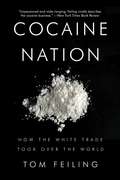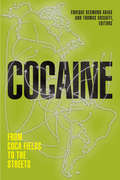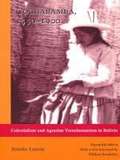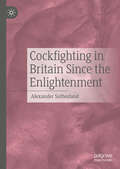- Table View
- List View
Coast to Coast: A Journey Across 1950s America
by Jan MorrisA first book by the author of "Fifty Years of Europe" finds its writer, living a very different identity and having recently reported on the first Everest ascent in 1953, traveling by various means across the United States and witnessing first hand the country's optimism and comparative innocence.
Coastal Defences: Processes, Problems and Solutions
by Peter W. FrenchCoastal Defences aims to present the broad spectrum of methods that engineers use to protect the coastline and investigates the sorts of issues that can arise as a result. The first section of the book examines 'traditional' hard techniques, such as sea walls and groynes, whilst the second looks at the more recent trend of using techniques more sympathetic to nature. By looking at each of the main methods of coastal protection in detail, the book investigates the rationale for using each method and the consequent management issues, presenting a case for and against each of the techniques.
Coastal Environments in Popular Song: Lost Horizons (Routledge Advances in the History of Bioethics)
by Glenn Fosbraey Lost HorizonsThis book examines how popular music is able to approach subjects of bio-politics, climate change, solastalgia, and anthropomorphisation, alongside its more common diet of songs about love, dancing, and break-ups – all while satisfying its primary remit of being entertaining and listenable. Nearly a thousand books have been published on bioethics since Van Rensselaer Potter’s Bioethics Bridge to the Future (1971), with a marked increase in the past 20 years. However, not one of these books has focused itself on popular music, something Christopher Partridge describes as ‘central to the construction of [our] identities, central to [our] sense of self, central to [our] well-being and, therefore, central to [our] social relations’. This edited collection examines popular music through a range of topics, from romance to climate change. Coastal Environments in Popular Song is perfect for students, scholars, and researchers alike interested in bioethics, social history, and the history of music.
Coastal Geography in Northeast Brazil: Analyzing Maritimity in the Tropics (SpringerBriefs in Latin American Studies)
by Eustogio Wanderley Correia DantasThis book studies the transformation of modern maritimity practices in coastal areas (such as swimming, navigation and tourism) and their implications to the development of Brazilian coastal cities, with an emphasis on the Northeast part of the country. It is a reflection on coastal geography in the tropics and the contemporary valorization of coastal cities from a socioeconomic, technological and symbolical point of view. The book highlights local fluxes on a regional and local scale, showing the incorporation of beach zones to spaces which were previously associated with so called traditional coastal practices (fishing activities and as harboring points). This book is dedicated to geography researchers and students.
Coastal Heritage and Cultural Resilience (Ethnobiology)
by Lisa L. Price Nemer E. NarchiThis book explores the knowledge, work and life of Pacific coastal populations from the Pacific Northwest to Panama. Center stage in this volume is the knowledge people acquire on coastal and marine ecosystems. Material and aesthetic benefits from interacting with the environment contribute to the ongoing building of coastal cultures. The contributors are particularly interested in how local knowledge -either recently generated or transmitted along generations- interfaces with science, conservation, policy and artistic expression. Their observations exhibit a wide array of outcomes ranging from resource and human exploitation to the magnification of cultural resilience and coastal heritage. The interdisciplinary nature of ethnobiology allows the chapter authors to have a broad range of freedom when examining their subject matter. They build a multifaceted understanding of coastal heritage through the different lenses offered by the humanities, social sciences, oceanography, fisheries and conservation science and, not surprisingly, the arts. Coastal Heritage and Cultural Resilience establishes an intimate bond between coastal communities and the audience in a time when resilience of coastal life needs to be celebrated and fortified.
Coastal Landscapes of the Mesolithic: Human Engagement with the Coast from the Atlantic to the Baltic Sea
by Almut SchülkeCoastal Landscapes of the Mesolithic: Human Engagement with the Coast from the Atlantic to the Baltic Sea explores the character and significance of coastal landscapes in the Mesolithic – on different scales and with various theoretical perspectives and methodological approaches. Mesolithic people were strongly connected to the sea, with coastal areas vital for subsistence and communication across the water. This anthology includes case studies from Scandinavia, western Europe and the Baltic area, presented by key international researchers. Topics addressed include large-scale analyses of the archaeological and geological development of coastal areas, the exploration of coastal environments with interdisciplinary methods, the discussion of the character of coastal settlements and of their possible networks, social and economic practices along the coast, as well as perceptions and cosmological aspects of coastal areas. Together, these topics and approaches contribute in an innovative way to the understanding of the complexity of topographically changing coastal areas as both border zones between land and sea and as connecting landscapes. Providing novel insights into the study of the Mesolithic as well as coastal areas and landscapes in general, the book is an important resource for researchers of the Mesolithic and coastal archaeology.
Coastal Landscapes of the Mesolithic: Human Engagement with the Coast from the Atlantic to the Baltic Sea
by Almut SchülkeCoastal Landscapes of the Mesolithic: Human Engagement with the Coast from the Atlantic to the Baltic Sea explores the character and significance of coastal landscapes in the Mesolithic – on different scales and with various theoretical perspectives and methodological approaches. Mesolithic people were strongly connected to the sea, with coastal areas vital for subsistence and communication across the water. This anthology includes case studies from Scandinavia, western Europe and the Baltic area, presented by key international researchers. Topics addressed include large-scale analyses of the archaeological and geological development of coastal areas, the exploration of coastal environments with interdisciplinary methods, the discussion of the character of coastal settlements and of their possible networks, social and economic practices along the coast, as well as perceptions and cosmological aspects of coastal areas. Together, these topics and approaches contribute in an innovative way to the understanding of the complexity of topographically changing coastal areas as both border zones between land and sea and as connecting landscapes. Providing novel insights into the study of the Mesolithic as well as coastal areas and landscapes in general, the book is an important resource for researchers of the Mesolithic and coastal archaeology.
Coastal Nature, Coastal Culture: Environmental Histories of the Georgia Coast (Environmental History and the American South)
by Paul S. Sutter; Paul M. PresslyAn essay collection exploring the history of 5,000-year relationship between human culture and nature on the Georgia coast. One of the unique features of the Georgia coast today is its thorough conservation. At first glance, it seems to be a place where nature reigns. But another distinctive feature of the coast is its deep and diverse human history. Indeed, few places that seem so natural hide so much human history. In Coastal Nature, Coastal Culture, editors Paul S. Sutter and Paul M. Pressly have brought together work from leading historians as well as environmental writers and activists that explores how nature and culture have coexisted and interacted across five millennia of human history along the Georgia coast, as well as how those interactions have shaped the coast as we know it today. The essays in this volume examine how successive communities of Native Americans, Spanish missionaries, British imperialists and settlers, planters, enslaved Africans, lumbermen, pulp and paper industrialists, vacationing northerners, Gullah-Geechee, nature writers, environmental activists, and many others developed distinctive relationships with the environment and produced well-defined coastal landscapes. Together these histories suggest that contemporary efforts to preserve and protect the Georgia coast must be as respectful of the rich and multifaceted history of the coast as they are of natural landscapes, many of them restored, that now define so much of the region.Contributors: William Boyd, S. Max Edelson, Edda L. Fields-Black, Christopher J. Manganiello, Tiya Miles, Janisse Ray, Mart A. Stewart, Drew A. Swanson, David Hurst Thomas, and Albert G. Way.
Coastal Problems: Geomorphology, Ecology and Society at the Coast
by Heather Viles Tom SpencerAs coastal populations burgeon, problems of erosion, pollution and coastal change are becoming ever more serious and necessitate scientifically informed management strategies. This authoritative new study discusses the causes of, and possible solutions to, some of the more pressing problems at the coast, against a background of the natural geomorphological and ecological workings of coastal environments.A holistic approach to the understanding of coastal problems is suggested, which integrates geomorphology, ecology and society through a consideration of the basic processes at work. Coastal problems are caused by both human and natural impacts, often working in conjunction with each other; thus drawing on their wide experience of temperate and tropical coasts the authors consider all types of coastal problems, ranging from those produced entirely naturally to those where the human impact dominates. Extensive use is made of case studies drawn from around the world, from beach erosion along the Nigerian coast to the recovery of the Vietnamese mangroves from war damage. A major theme of the book is that, given recent downgrading of predictions of future sea level rise, it is the distinctive geomorphological, ecological and societal aspects of each coast which are the vital factors.'Coastal Problems' brings together material vital to any attempts to understand and manage our coasts and will be of interest to all those concerned with the environment and its management.
Coastal Shrines and Transnational Maritime Networks across India and Southeast Asia
by Himanshu Prabha RayThis book breaks new ground by examining trans-oceanic connectivity through the perspective of coastal shrines and maritime cultural landscapes across the Bay of Bengal and the South China Sea. It covers a period of expanding networks and cross-cultural encounters from the 3rd century BCE to the 13th century CE. The book examines the distinctiveness of these shrines, and highlights their interconnections, and their role in social integration in South and Southeast Asia. By drawing on data from shipwreck sites, the author elaborates on the material and religious intersections and transmissions between cultures across the seas. Many of these coastal shrines survived into the colonial period when they came to be admired for their aesthetic value as ‘monuments’. As nation states of the region became independent, these shrines were often inscribed on UNESCO’s World Heritage List on account of their Outstanding Universal Values. The book argues that in the 21st century there is a need to promote the cultural connectivity of the past as transnational heritage on UNESCO’s global platform to preserve and protect our shared heritage. The volume will be essential reading for academics and researchers of archaeology, anthropology, museum and heritage studies, history of South and Southeast Asia, religious studies, cultural studies, and Asian studies.
Coastal Systems
by Simon HaslettThe coast represents the crossroads between the oceans, land and atmosphere, and all three contribute to the physical and ecological evolution of coastlines. Coasts are dynamic systems, with identifiable inputs and outputs of energy and material. Changes to input force coasts to respond, often in dramatic ways as attested by the impacts of the Indian Ocean tsunami in 2004, the landfall of Hurricane Katrina along the Gulf Coast of the USA in 2005, and the steady rise of global warming driven sea-level. More than half the world’s human population lives at the coast, and here people often come into conflict with natural coastal processes. Research continues to unravel the relationship between coastal processes and society, so that we may better appreciate, understand, manage and live safely within this unique global environment. Coastal Systems offers a concise introduction to the processes, landforms, ecosystems and management of this important global environment. New to the second edition is a greater emphasis on the role of high-energy events, such as storms and tsunamis, which have manifested themselves with catastrophic effects in recent years. There is also a new concluding chapter, and updated guides to the ever-growing coastal literature. Each chapter is illustrated and furnished with topical case studies from around the world. Introductory chapters establish the importance of coasts, and explain how they are studied within a systems framework. Subsequent chapters explore the role of waves, tides, rivers and sea-level change in coastal evolution. Students will benefit from summary points, themed boxes, engaging discussion questions and new graded annotated guides to further reading at the end of each chapter. Additionally, a comprehensive glossary of technical terms and an extensive bibliography are provided. The book is highly illustrated with diagrams and original plates. The comprehensive balance of illustrations and academic thought provides a well balanced view between the role of coastal catastrophes and gradual processes, also examining the impact humans and society have and continue to have on the coastal environment.
Coastal and Estuarine Management (Routledge Environmental Management)
by Peter FrenchThe coast cannot be left to nature to determine its fate. Wealth, property, economic interests, recreation, tourism and wildlife are all threatened. Coasts are an administrative battle ground and one of the most important and widely examined topics in environmental management.Coastal and Estuarine Management examines the issues surrounding the human use and abuse of estuarine and coastal environments. Emphasising the importance and significance of this natural resource, the uses and conflicts which occur and the results of human activity, this book explains the ways in which conservation and management policies and practices can protect this productive and diverse ecosystem.Examples and real-life case studies illustrate the effect of human intervention, both from an historic and contemporary perspective. Exposing the environmental consequences of estuarine pollution, Peter French highlights the need for management strategies to promote a sustainable development ethic for estuaries.
Cobalt Red: How the Blood of the Congo Powers Our Lives
by Siddharth KaraThe revelatory Pulitzer Prize finalist for General Nonfiction, New York Times and Publishers Weekly bestseller, shortlisted for the Financial Times Best Business Book of the Year Award.An unflinching investigation reveals the human rights abuses behind the Congo’s cobalt mining operation—and the moral implications that affect us all.Cobalt Red is the searing, first-ever exposé of the immense toll taken on the people and environment of the Democratic Republic of the Congo by cobalt mining, as told through the testimonies of the Congolese people themselves. Activist and researcher Siddharth Kara has traveled deep into cobalt territory to document the testimonies of the people living, working, and dying for cobalt. To uncover the truth about brutal mining practices, Kara investigated militia-controlled mining areas, traced the supply chain of child-mined cobalt from toxic pit to consumer-facing tech giants, and gathered shocking testimonies of people who endure immense suffering and even die mining cobalt.Cobalt is an essential component to every lithium-ion rechargeable battery made today, the batteries that power our smartphones, tablets, laptops, and electric vehicles. Roughly 75 percent of the world’s supply of cobalt is mined in the Congo, often by peasants and children in sub-human conditions. Billions of people in the world cannot conduct their daily lives without participating in a human rights and environmental catastrophe in the Congo. In this stark and crucial book, Kara argues that we must all care about what is happening in the Congo—because we are all implicated.
Coca Wine: Angelo Mariani’s Miraculous Elixir and the Birth of Modern Advertising
by Aymon De LestrangeA lavishly illustrated history of coca wine and the revolutionary advertising methods that made it a world-wide success • Follows 19th-century pharmacist Angelo Mariani’s interest in coca from medical uses to the development and healing effects of his world-famous coca wine, Vin Mariani • Explores the botany of coca, how it differs from cocaine, its traditional uses, and early scientific studies on coca from doctors, including Sigmund Freud • Examines Mariani’s highly successful international advertising campaigns, the first to use celebrity endorsements, including testimonies from Pope Benedict XV, Sarah Bernhardt, Thomas Edison, Jules Verne, H. G. Wells, William McKinley, Emile Zola, and Alphonse Mucha One of the oldest and most potent natural stimulants, the leaves of the coca plant are the organic source from which cocaine is synthesized. Fresh coca leaves and products made from them have verified medicinal and healing properties--and not the same addictive qualities or negative side effects as cocaine. In the late 19th century coca products became hugely successful in Europe and the United States. The most famous was Vin Mariani, a coca-based tonic wine developed by Corsican pharmacist Angelo Mariani (1838-1914). Many celebrities sang its praises, including Pope Benedict XV, Sarah Bernhardt, Thomas Edison, H. G. Wells, William McKinley, Emile Zola, and the doctors of Ulysses S. Grant, who credited Vin Mariani with giving him the strength to finish his memoirs before his death. In this full-color illustrated history of coca wine, the first of its kind, author Aymon de Lestrange follows Mariani’s interest in coca from its medicinal applications to the creation of the tonic wine. The author explores the botany of coca, how it differs from cocaine, its traditional use in pre-Columbian America, and scientific studies on coca from the 17th through 19th centuries, including from Sigmund Freud, who was a known user. He describes the introduction of coca in the U.S. and France and the many coca preparations then available at drugstores. He also studies the introduction of cocaine in these two countries and the prohibition laws that followed. Aymon de Lestrange demonstrates how Mariani became, in many ways, the father of modern advertising with his highly successful advertising campaigns. He includes vivid reproductions of Mariani’s advertisements, many not seen since their original publication in the late 19th and early 20th centuries, and shows how Mariani commissioned the top writers and artists of the day, such as Jules Chéret and Alphonse Mucha, to produce works celebrating coca wine. The author reveals how Vin Mariani was the forerunner of Coca-Cola, which clearly plagiarized not only Mariani’s product but also his advertising methods. Looking to the future of coca, the author shows how it has gained renewed interest in the scientific community for its therapeutic and nutritional properties and in the spiritual community, which is seeking to rehabilitate the reputation of coca, the sacred plant of the Incas.
Coca Yes, Cocaine No: How Bolivia's Coca Growers Reshaped Democracy
by Thomas GrisaffiIn Coca Yes, Cocaine No Thomas Grisaffi traces the political ascent and transformation of the Movement toward Socialism (MAS) from an agricultural union of coca growers into Bolivia's ruling party. When Evo Morales—leader of the MAS—became Bolivia's president in 2006, coca growers celebrated his election and the possibility of scaling up their form of grassroots democracy to the national level. Drawing on a decade of ethnographic fieldwork with coca union leaders, peasant farmers, drug traffickers, and politicians, Grisaffi outlines the tension that Morales faced between the realities of international politics and his constituents, who, even if their coca is grown for ritual or medicinal purposes, are implicated in the cocaine trade and criminalized under the U.S.-led drug war. Grisaffi shows how Morales's failure to meet his constituents' demands demonstrates that the full realization of alternative democratic models at the local or national level is constrained or enabled by global political and economic circumstances.
Cocaina: A Book on Those Who Make It
by Magnus Linton John EasonWhen Pablo Escobar, Colombia's "King of Cocaine," was killed, the world thought-or hoped-the cocaine industry would crumble. But ten years later the country's production had almost quadrupled, and since 2001, Colombia has produced more than 60% of all the cocaine consumed in the world.Cocaine is both a curse and a salvation for Colombians. Farmers grow coca for cash but fear discovery. Families must cooperate with drug-funded guerrillas or go on the run. Destitute teens become trained killers for a quick buck in a ruthless underworld where few survive for long.At the same time, tension grows between Colombia's right-wing government and its socialist neighbors in Latin America. With the failed US War on Drugs playing into this geopolitical brew, the future of cocaine is about more than what happens to street dealers and their customers.Based on three years of research and more than 100 interviews with growers, traffickers, assassins, refugees, police, politicians, and drug tourists, Cocaína is a brilliant work of journalism, and an insight into one of the world's most troubling industries.
Cocaine Cowboys: The Deadly Rise of Ireland's Drug Lords
by Nicola TallantThe History of Cocaine in IrelandFrom the first street dealers to modern-day crime lords, author Nicolla Tallant uncovers how cocaine has become the most dangerous economic boom in Irish history.Ireland’s narco war explained. In less than a few decades, Ireland has become the country with the highest intake of cocaine in the world. But how did this come to be? Who was behind this, and what do they gain from it today? Investigative journalist Nicolla Tallant answers these questions in Cocaine Cowboys, a true crime cartel book that documents the people behind the biggest smuggling operation of illegal drugs into Ireland and how it still affects the country today.How the cocaine cowboys rose to power. Colombia’s most famous illegal export held a lot of promise for not just users, but also sellers. Each chapter in this dirty money documentary book dives into how these street dealers became powerful figures in Irish economics through illegal trafficking, dealings, and the growth of cocaine abuse. By the end, readers will not only learn how the drug cartel created chaos and violence in Ireland to gain riches, but also how they left their mark on the history of cocaine itself.Inside Cocaine Cowboys, you’ll find:Facts about famous Irish crime families and organizationsHow cocaine became available in every rural pub across IrelandTrue stories of homicide cases linked to the cocaine empireHow the Irish government and public are combating the narcotic epidemic todayIf you liked Pain Killer, We Don’t Know Ourselves, or The Best New True Crime Stories: Well-Mannered Crooks, Rogues, and Criminals, then you’ll love Cocaine Cowboys.
Cocaine Nation: How The White Trade Took Over The World
by Thomas FeilingA Simon & Schuster eBook. Simon & Schuster has a great book for every reader.
Cocaine Nation: How the White Trade Took Over the World
by Thomas FeilingCutting through the myths about the white trade, this is the story of cocaine as it's never been told before. Cocaine is big business and getting bigger. Governments spend millions on a losing war against it, yet it's still the drug of choice in the West. In Cocaine Nation, Tom Feiling travels the trade routes from Colombia via Miami, Kingston, and Tijuana to London and New York. Cutting through the myths about the white trade, this is the story of cocaine as it's never been told before.
Cocaine Nation: How the White Trade Took Over the World
by Thomas FeilingCutting through the myths about the white trade, this is the story of cocaine as it's never been told before. Cocaine is big business and getting bigger. Governments spend millions on a losing war against it, yet it’s still the drug of choice in the West. In Cocaine Nation, Tom Feiling travels the trade routes from Colombia via Miami, Kingston, and Tijuana to London and New York. Cutting through the myths about the white trade, this is the story of cocaine as it’s never been told before.
Cocaine: From Coca Fields to the Streets
by Enrique Desmond Arias and Thomas GrisaffiThe contributors to Cocaine analyze the contemporary production, transit, and consumption of cocaine throughout the Americas and the illicit economy's entanglement with local communities. Based on in-depth interviews and archival research, these essays examine how government agents, acting both within and outside the law, and criminal actors seek to manage the flow of illicit drugs to both maintain order and earn profits. Whether discussing the moral economy of coca cultivation in Bolivia, criminal organizations and drug traffickers in Mexico, or the routes cocaine takes as it travels into and through Guatemala, the contributors demonstrate how entire ways of life are built around cocaine commodification. They consider how the authority of state actors is coupled with the self-regulating practices of drug producers, traffickers, and dealers, complicating notions of governance and of the relationships between economic and moral economies. The collection also outlines a more progressive drug policy that acknowledges the important role drugs play in the lives of those at the urban and rural margins.Contributors. Enrique Desmond Arias, Lilian Bobea, Philippe Bourgois, Anthony W. Fontes, Robert Gay, Paul Gootenberg, Romain Le Cour Grandmaison, Thomas Grisaffi, Laurie Kain Hart, Annette Idler, George Karandinos, Fernando Montero, Dennis Rodgers, Taniele Rui, Cyrus Veeser, Autumn Zellers-León
Cochabamba, 1550–1900: Colonialism and Agrarian Transformation in Bolivia
by Brooke LarsonWinner of the 1990 Best Book Award from the New England Council on Latin American StudiesThis study of Bolivia uses Cochabamba as a laboratory to examine the long-term transformation of native Andean society into a vibrant Quechua-Spanish-mestizo region of haciendas and smallholdings, towns and villages, peasant markets and migratory networks caught in the web of Spanish imperial politics and economics. Combining economic, social, and ethnohistory, Brooke Larson shows how the contradictions of class and colonialism eventually gave rise to new peasant, artisan, and laboring groups that challenged the evolving structures of colonial domination. Originally published in 1988, this expanded edition includes a new final chapter that explores the book's implications for understanding the formation of a distinctive peasant political culture in the Cochabamba valleys over the eighteenth and nineteenth centuries.
Cockfighting in Britain Since the Enlightenment
by Alexander SutherlandThis book looks at the relationship of the cock and cockfighting in Britain from the Enlightenment through the modern era, showing the societal and culture changes that affected that relationship. It examines the evolution of the cock in religion and sport, the evolution of cockfighting as a sport, the changing culture of pastimes, and the historical development of humankind’s relationship with animals and the philosophy of cruelty to animals and their rights.
Cockfighting in Britain from Antiquity to the Enlightenment
by Alexander SutherlandThis book looks at the relationship of the cock and cockfighting in Britain from ancient times to the early modern period, showing the societal and cultural changes that affected that relationship. It examines the evolution of the cock’s role in religion and sport and, the evolution of cockfighting as a sport, in light of the changing culture of pastimes, the historical development of humankind’s relationship with animals, and the philosophy related to animal cruelty and animal rights.
Cocoa & Kinship In Guana
by OkaliPublished in the year 1983, Cocoa & Kinship In Guana is a valuable contribution to the field of Social Science and Anthropology.
